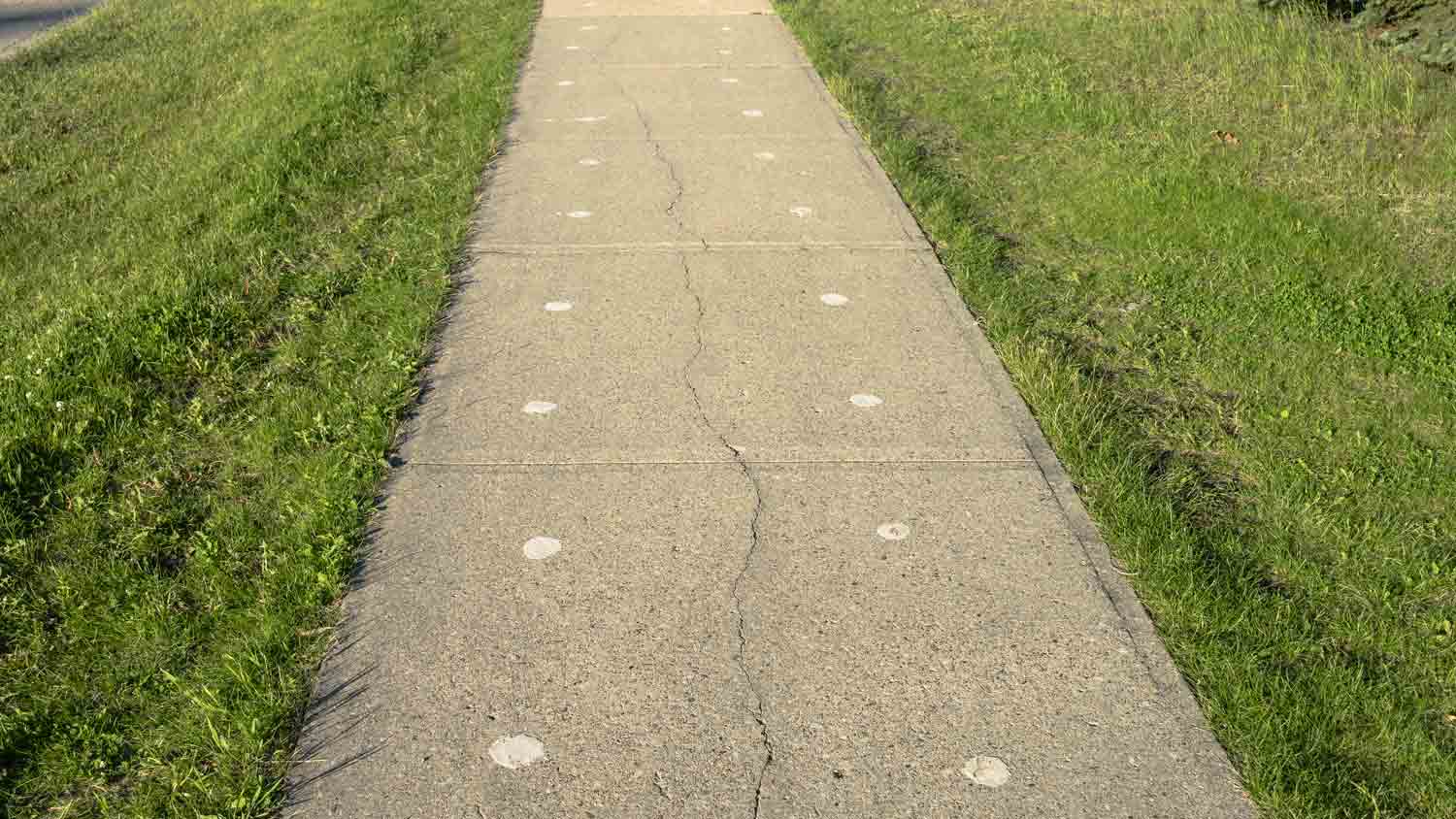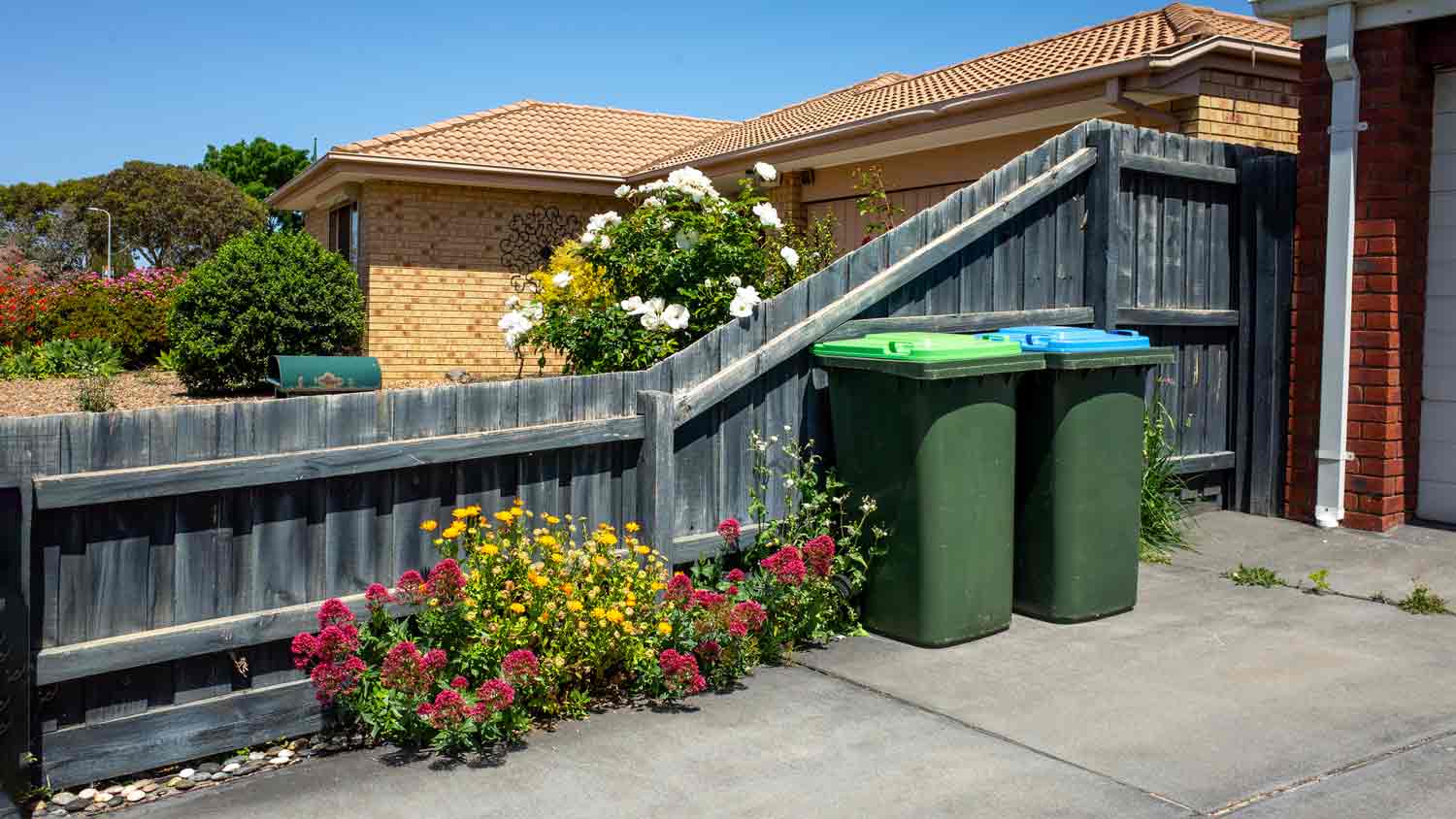
Wondering about mudjacking costs? Discover prices, key cost factors, and tips to save on your concrete leveling project.
Level up your patio game with concrete leveling
Concrete leveling lifts sinking slabs by filling spaces underneath.
This process addresses unevenness or water issues.
You can choose between various concrete leveling methods, including mudjacking, poly leveling, and stone slurry grout leveling.
Concrete leveling costs less than a full slab replacement, and it’s recommended to hire a professional for the job.
Sinking concrete is tough to ignore, whether you notice your front steps shifting to one side, your deck furniture creeping off a tilting patio, or your driveway becoming uneven. These issues are often signs of problems underneath your concrete, which might not be solved by simply replacing the slab. Learn what concrete leveling is and why it may be the solution you need to put your concrete back in place.

Concrete leveling is a process used to fill voids under sagging concrete slabs, including steps, porches, patios, sidewalks, and driveways. It involves drilling holes into the existing concrete and pumping a leveling material through those holes and underneath the slab. The material stabilizes loose soil and raises the level of the sunken slab back to where it belongs.
Level surfaces are especially important for concrete driveways, walkways, and sidewalks, where uneven slabs could cause people to trip or catch the wheels of scooters and bicycles. You may also want to fix sinking outdoor patios where you spend a lot of time. Tearing up and replacing a slab can be messy and time-consuming—not to mention tough on your lawn and landscaping—so you may prefer concrete lifting if conditions are right.
Here are some signs you might need concrete leveling:
Settling slabs: Any slab that has settled at least a quarter-inch below its original level may be a candidate for concrete leveling. Often, you’ll be able to see the height difference between adjacent slabs.
Drainage or water issues: When it rains, you may notice water seeping into your basement, which can sometimes be caused by concrete patios or walkways settling next to your house.
Voids beneath slabs: Voids might develop under concrete without causing immediate problems. Slabs may rock when stepped on or driven over, or they may sound hollow when tapped, indicating a lack of support underneath.
There are two main methods of leveling concrete: mudjacking and poly leveling. Stone slurry grout leveling is also used in some cases. You can hire professional concrete leveling services for any of these methods. Below are the main differences between them and what projects they’re best suited for.
Mudjacking involves “jacking” concrete up from below using a mud-like mixture of cement, water, soil, and sand. First, several holes (about two inches wide) are drilled into the existing concrete slab. The material is then injected through the holes to lift the slab from below to its original height. Here are the pros and cons of mudjacking:
| Mudjacking Pros | Mudjacking Cons |
|---|---|
| Costs less than poly leveling or a complete slab replacement | Takes up to 48 hours to cure |
| Doesn’t require heavy equipment or large crews | Drilling large holes can cause cracks in your slab |
| Lasts 5–10 years | Material has some cons: it’s not waterproof, can deteriorate, and might worsen sinking in some cases |
| Works for intact walkways, patios, steps, and driveways | Won’t work for garage floors, basements, foundation repair, pools, or heavily damaged slabs |
Another concrete leveling method is poly leveling or polyurethane foam concrete raising. Like mudjacking, it involves drilling small holes into the slab. Instead of cement and mud, however, a lightweight polyurethane foam is injected beneath the concrete. This foam rapidly expands to lift the slab to its original position. You may hear this method called “slabjacking,” though that term is also sometimes used for mudjacking. Poly leveling costs more than mudjacking but has a longer lifespan and faster curing time. Here are the pros and cons of poly leveling:
| Poly Leveling Pros | Poly Leveling Cons |
|---|---|
| Doesn’t require heavy equipment or large crews | Costs more than mudjacking |
| Can last 20 years or more | Won’t work on heavily damaged slabs |
| Cures in under an hour | Hole patches may be visible due to a color mismatch with the existing concrete |
| Holes required are smaller, just 5/8 inch in diameter | Foam can cure too quickly if not properly controlled |
| Works for garage floors, basements, foundation problems, and pools | Risk of over-lifting if the foam expands too much |
Stone slurry concrete leveling works by combining finely crushed limestone with water to form a slurry. The mixture is pumped beneath the concrete slabs through small holes, filling the uneven areas and lifting the slab to level. The cured slurry creates a strong surface that can withstand significant weight. Here are the pros and cons of stone slurry grout concrete leveling:
| Stone Slurry Concrete Leveling Pros | Stone Slurry Concrete Leveling Cons |
|---|---|
| Very durable—can handle heavy pressure | Holes are larger than poly leveling—normally 1’’ |
| Sourced from local limestone, which is a natural and eco-friendly material | More expensive than mudjacking |
| Safe for pets, landscaping, and lawns | Heavier material adds weight to soil |
| Longer lifespan than mudjacking | Longer curing time than poly leveling |
"There are some cases where concrete leveling doesn’t always work, and it’s not a foolproof method," says Matt DiBara, Expert Review Board member and owner of DiBara Masonry. "In these instances, the slab isn’t lifted high enough or breaks after being raised, which then requires a slab replacement."
Concrete leveling works with the existing concrete, while concrete replacement tears out the existing concrete to pour a new foundation or slab. Although concrete replacement is a costlier process, it’s recommended to go this route if the existing concrete has broken into several smaller pieces, is badly in need of repair, or has structural damage.
If your slab is intact, concrete leveling is often more cost-effective than a full slab replacement. For a replacement, you’ll pay to break up the old slab, haul away debris, deliver new concrete, and then have a new slab poured.
Breaking up and removing the existing concrete costs around $2 to $6 per square foot. You’ll then pay an additional $4.50 to $10.50 per square foot for the cost of a new concrete slab. This brings the total cost to around $6.50 to $16.50 per square foot.
In contrast, here are the average costs of different concrete leveling methods:
| Concrete Leveling Method | Average Cost per Sq. Ft. |
|---|---|
| Mudjacking | $3–$6 |
| Polyurethane foam | $5–$25 |
| Stone slurry grout | $7–$25 |
| Self-leveling | $2–$6 |
Mudjacking prices are the least expensive at around $3 to $6 per square foot. For poly leveling, you’ll spend anywhere from $5 to $25 per square foot. Before you decide, consider calling in a local concrete mudjacking service to get a quote and ensure the underlying issues causing your sinking concrete are properly addressed.
While the average cost of a concrete leveling project is around $1,174, the final price will largely depend on many factors, including the size of the area, its accessibility, and labor costs.
DIY concrete leveling is an advanced project that requires specialized equipment, materials, and skill. Unless you have experience with concrete leveling and the necessary equipment, your best bet is to hire a pro to level your concrete. A contractor who specializes in concrete leveling will be able to tackle the job safely and get the best results, especially if you’re working with a large area or concrete damage that can cause structural issues.
From average costs to expert advice, get all the answers you need to get your job done.

Wondering about mudjacking costs? Discover prices, key cost factors, and tips to save on your concrete leveling project.

Don’t let sinking concrete capsize your budget. Learn about concrete leveling costs and the available methods to plan ahead for your project.

DIY mudjacking is an advanced task, but learning how to raise a concrete slab is great to know for many scenarios. Let's take a look at how to DIY mudjack.

Sunken concrete can be a structural issue, but a professional can easily repair it. Ask these concrete injection leveling and mudjacking questions before you hire.

Mudjacking is a common method for leveling concrete. Learn how long mudjacking lasts and what factors contribute to its lifespan.

Leveling concrete slabs around your home is no small feat. Learn who to call to level your concrete slab and why they’re the right choice.